第四章 翻译的技巧 (2)
- 格式:doc
- 大小:41.00 KB
- 文档页数:4
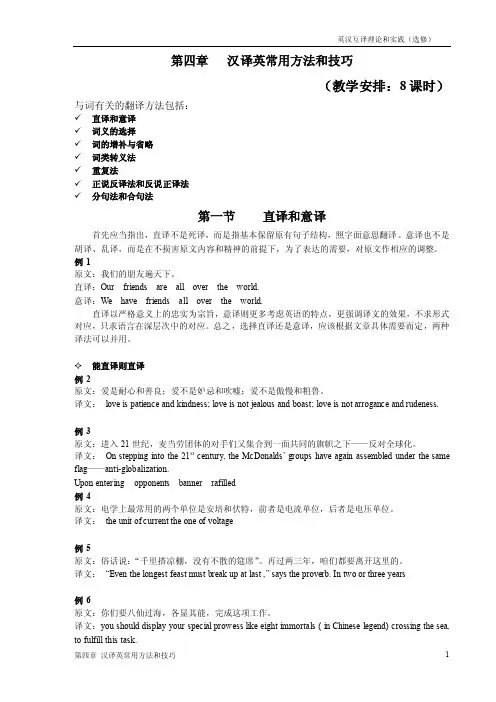
第四章汉译英常用方法和技巧(教学安排:8课时)与词有关的翻译方法包括:✓直译和意译✓词义的选择✓词的增补与省略✓词类转义法✓重复法✓正说反译法和反说正译法✓分句法和合句法第一节直译和意译首先应当指出,直译不是死译,而是指基本保留原有句子结构,照字面意思翻译。
意译也不是胡译、乱译,而是在不损害原文内容和精神的前提下,为了表达的需要,对原文作相应的调整。
例1原文:我们的朋友遍天下。
直译:Our friends are all over the world.意译:We have friends all over the world.直译以严格意义上的忠实为宗旨,意译则更多考虑英语的特点,更强调译文的效果,不求形式对应,只求语言在深层次中的对应。
总之,选择直译还是意译,应该根据文章具体需要而定,两种译法可以并用。
✧能直译则直译例2原文:爱是耐心和善良;爱不是妒忌和吹嘘;爱不是傲慢和粗鲁。
译文:love is patience and kindness; love is not jealous and boast; love is not arrogance and rudeness.例3原文:进入21世纪,麦当劳团体的对手们又集合到一面共同的旗帜之下——反对全球化。
译文:On stepping into the 21st century, the McDonalds’ groups have again assembled under the same flag——anti-globalization.Upon entering opponents banner rafilled例4原文:电学上最常用的两个单位是安培和伏特,前者是电流单位,后者是电压单位。
译文:the unit of current the one of voltage例5原文:俗话说:“千里搭凉棚,没有不散的筵席”。
再过两三年,咱们都要离开这里的。

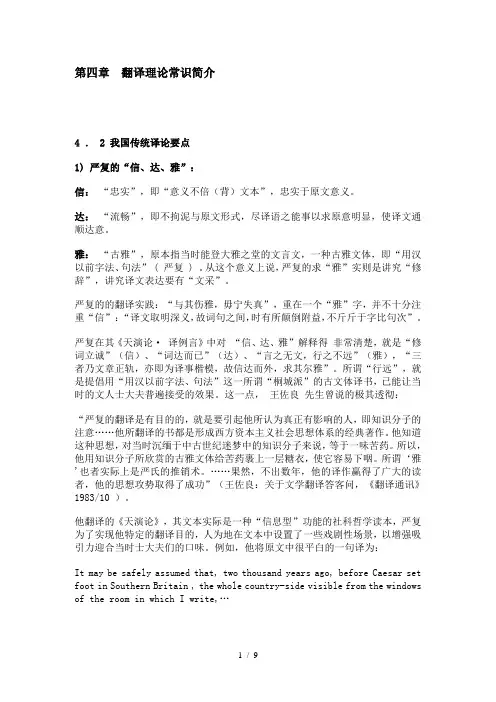
第四章翻译理论常识简介4 . 2 我国传统译论要点1) 严复的“信、达、雅”:信:“忠实”,即“意义不倍(背)文本”,忠实于原文意义。
达:“流畅”,即不拘泥与原文形式,尽译语之能事以求原意明显,使译文通顺达意。
雅:“古雅”,原本指当时能登大雅之堂的文言文,一种古雅文体,即“用汉以前字法、句法” ( 严复 ) 。
从这个意义上说,严复的求“雅”实则是讲究“修辞”,讲究译文表达要有“文采”。
严复的的翻译实践:“与其伤雅,毋宁失真”,重在一个“雅”字,并不十分注重“信”:“译文取明深义,故词句之间,时有所颠倒附益,不斤斤于字比句次”。
严复在其《天演论· 译例言》中对“信、达、雅”解释得非常清楚,就是“修词立诚”(信)、“词达而已”(达)、“言之无文,行之不远”(雅),“三者乃文章正轨,亦即为译事楷模,故信达而外,求其尔雅”。
所谓“行远”,就是提倡用“用汉以前字法、句法”这一所谓“桐城派”的古文体译书,已能让当时的文人士大夫普遍接受的效果。
这一点,王佐良先生曾说的极其透彻:“严复的翻译是有目的的,就是要引起他所认为真正有影响的人,即知识分子的注意……他所翻译的书都是形成西方资本主义社会思想体系的经典著作。
他知道这种思想,对当时沉缅于中古世纪迷梦中的知识分子来说,等于一味苦药。
所以,他用知识分子所欣赏的古雅文体给苦药裹上一层糖衣,使它容易下咽。
所谓‘雅'也者实际上是严氏的推销术。
……果然,不出数年,他的译作赢得了广大的读者,他的思想攻势取得了成功”(王佐良:关于文学翻译答客问,《翻译通讯》1983/10 )。
他翻译的《天演论》,其文本实际是一种“信息型”功能的社科哲学读本,严复为了实现他特定的翻译目的,人为地在文本中设置了一些戏剧性场景,以增强吸引力迎合当时士大夫们的口味。
例如,他将原文中很平白的一句译为:It may be safely assumed that, two thousand years ago, before Caesar set foot in Southern Britain , the whole country-side visible from the windows of the room in which I write,…赫胥黎独处一室之中,在英伦之南,背山而面野。
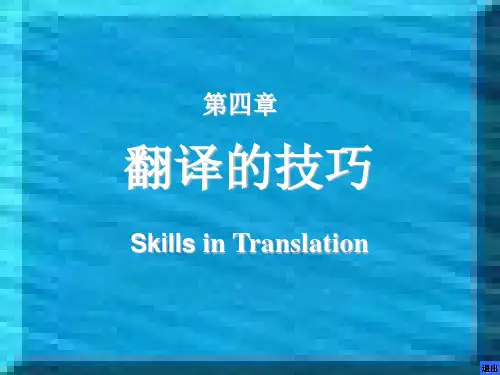
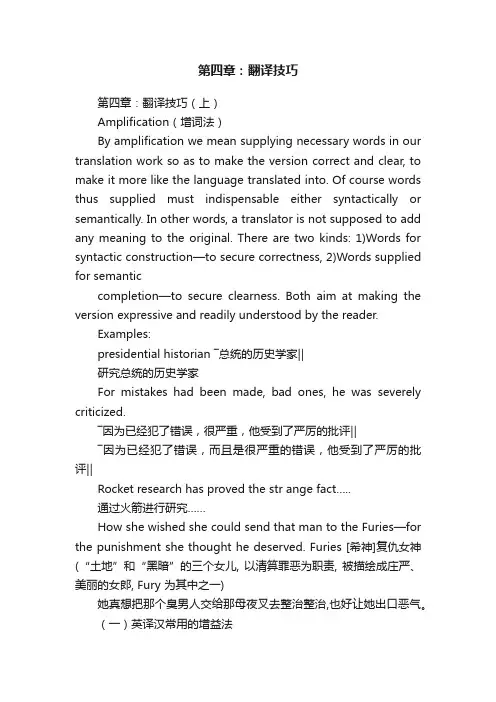
第四章:翻译技巧第四章:翻译技巧(上)Amplification(增词法)By amplification we mean supplying necessary words in our translation work so as to make the version correct and clear, to make it more like the language translated into. Of course words thus supplied must indispensable either syntactically or semantically. In other words, a translator is not supposed to add any meaning to the original. There are two kinds: 1)Words for syntactic construction—to secure correctness, 2)Words supplied for semanticcompletion—to secure clearness. Both aim at making the version expressive and readily understood by the reader.Examples:presidential historian ―总统的历史学家‖研究总统的历史学家For mistakes had been made, bad ones, he was severely criticized.―因为已经犯了错误,很严重,他受到了严厉的批评‖―因为已经犯了错误,而且是很严重的错误,他受到了严厉的批评‖Rocket research has proved the str ange fact…..通过火箭进行研究……How she wished she could send that man to the Furies—for the punishment she thought he deserved. Furies [希神]复仇女神(“土地”和“黑暗”的三个女儿, 以清算罪恶为职责, 被描绘成庄严、美丽的女郎, Fury 为其中之一)她真想把那个臭男人交给那母夜叉去整治整治,也好让她出口恶气。
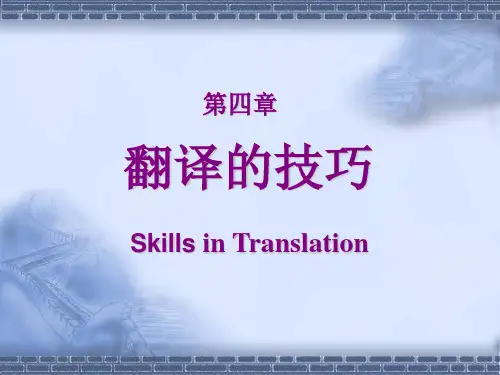
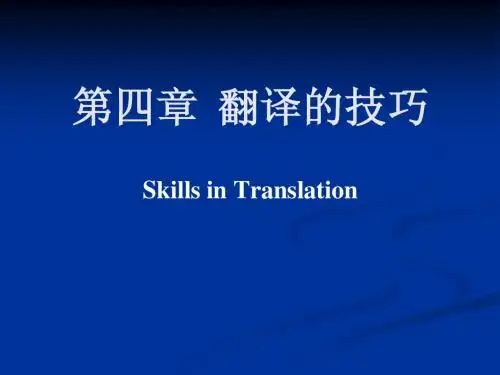
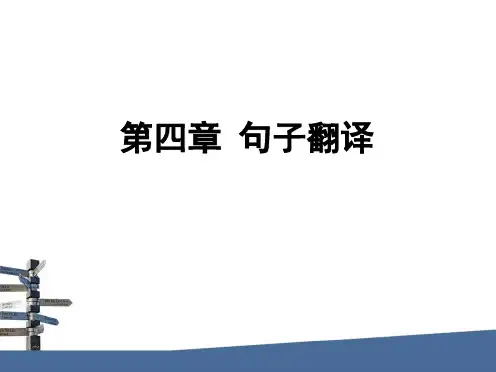
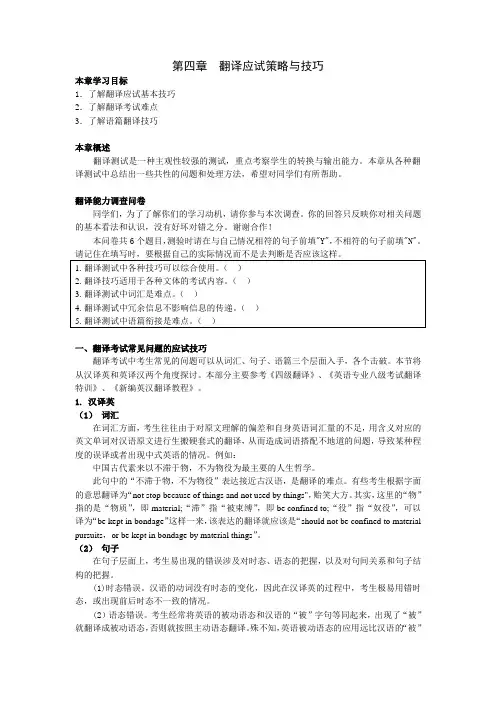
第四章翻译应试策略与技巧本章学习目标1.了解翻译应试基本技巧2.了解翻译考试难点3.了解语篇翻译技巧本章概述翻译测试是一种主观性较强的测试,重点考察学生的转换与输出能力。
本章从各种翻译测试中总结出一些共性的问题和处理方法,希望对同学们有所帮助。
翻译能力调查问卷同学们,为了了解你们的学习动机,请你参与本次调查。
你的回答只反映你对相关问题的基本看法和认识,没有好坏对错之分。
谢谢合作!本问卷共6个题目,测验时请在与自己情况相符的句子前填"Y",不相符的句子前填"N"。
请记住在填写时,要根据自己的实际情况而不是去判断是否应该这样。
1.翻译测试中各种技巧可以综合使用。
()2.翻译技巧适用于各种文体的考试内容。
()3.翻译测试中词汇是难点。
()4.翻译测试中冗余信息不影响信息的传递。
()5.翻译测试中语篇衔接是难点。
()一、翻译考试常见问题的应试技巧翻译考试中考生常见的问题可以从词汇、句子、语篇三个层面入手,各个击破。
本节将从汉译英和英译汉两个角度探讨。
本部分主要参考《四级翻译》、《英语专业八级考试翻译特训》、《新编英汉翻译教程》。
1. 汉译英(1)词汇在词汇方面,考生往往由于对原文理解的偏差和自身英语词汇量的不足,用含义对应的英文单词对汉语原文进行生搬硬套式的翻译,从而造成词语搭配不地道的问题,导致某种程度的误译或者出现中式英语的情况。
例如:中国古代素来以不滞于物,不为物役为最主要的人生哲学。
此句中的“不滞于物,不为物役”表达接近古汉语,是翻译的难点。
有些考生根据字面的意思翻译为“not stop because of things and not used by things",贻笑大方。
其实,这里的“物”指的是“物质”,即material;“滞”指“被束缚”,即be confined to;“役”指“奴役”,可以译为“be kept in bondage”这样一来,该表达的翻译就应该是“should not be confined to material pursuits,or be kept in bondage by material things”。
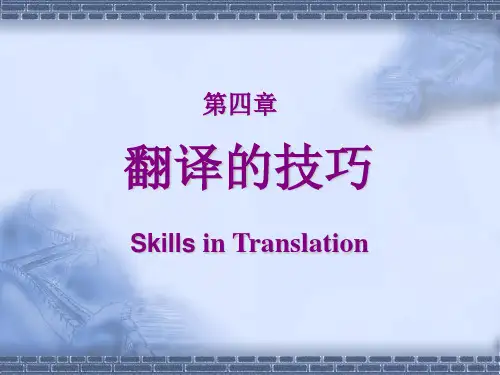
第四章 翻译的技巧(2) 译例与练习
班级:2010级13班 姓名: 黎淑君 学号:07101318
二、变态: 被动语态的译法
(一)英语中被动结构的句子译成汉语主动句可以有几种不同情况。
1. 英语原文中的主语在译文中仍作主语
⑴ The streets are filled with vehicles.
⑵ The murderer was caught at last.
⑶ Students are kept on probation for one semester.
2.英语原文中的主语在译文中译作宾语
⑴ By the end of the last week, over 500 people had been saved since the earthquake.
3.原文中的被动句汉译时,有时可译为无主语句
⑴Some measures should be adopted to deal with the urgent situation.
⑵ Time can always be found to do things one wants to do.
译为代表语的汉语主动句
⑴ He said the pact had now been reduced to less than a shadow.
翻译练习:
① Happy reunion is much left among the family members at the Spring Festival. (英语原文
中的主语在译文中仍作主语)
② The coming oral test is said to be rather difficult, so I feel a bit nervous.
③ The decision to go abroad was not taken easily.
(二)译成汉语被动句
1.汉语也有用被动形式来表达的情况。
⑴ The delegates from the remote areas were given a hearty welcome.
⑵ The economic development is decided to great extent by science and technology.
⑶ The subject will be further dealt with in that essay.
⑷ I couldn’t sleep at all since I was troubled by the noise from the worksite.
(三)有by-phrase的被动语态的翻译 :这一类句子汉译时,可采用多种方式来表达。
⑴ Many expect that he will be outed by one of his rivals.
⑵ His sincerity is illustrated not only by his proposal but also by his deeds.
⑶ Here is a clear case of the course of human history being affected by the scientific and
technological revolution.
(四)It+be+p.p句型的翻译
⑴ It is considered not advisable to act that way.
⑵ It should be understood that to err is human.
在语态翻译中,有一些常见的英语被动结构的汉译法,特收之罗列于下,以供翻译时参
考之用。 ⅰ须增补主语的
It is asked that ... 有人会问 It is asserted that ... 有人主张
It is believed that ... 有人相信 It is felt that ... 有人感到
It is found that ... 有人发现 It is generally considered that ...大家认为
It is noticed that ... 人们注意到 It is pointed that ... 有人指出
It is regarded that ... 人们认为 It is stressed that ... 有人强调
It is suggested that ... 有人建议 It is thought that ... 人们认为
It will be said that ... 有人会说 It was told that ... 有人曾经说
It is well known that ...大家知道/众所周知
ⅱ 无须增补主语的
It can be seen that ... 可见 It cannot be denied that ... 不可否认
It has been calculated that ... 据计算 It has been reviewed that ... 回顾了
It is arranged that ... 已商定 It is assumed that ... 假定/据推测
It is declared that ... 据宣称 It is demonstrated that ... 据证实
It is enumerated that ... 列举出 It is hoped that ... 希望
It is learned that ... 据说 It is mentioned that ... 上文提到
It is outlined that ... 概括地说 It is preferred that ... 最好
It is stated that ... 据说 It is supposed that ... 假定
It must be admitted that ... 必须承认 It must be pointed out that ...必须指出
It will be seen from this that ... 由此可见
It may be said without fear that ... 可以毫不夸张地说
翻译练习:
① It is rumored that the accident was due to negligence. (It+be+p.p句型的翻译)
② The result of the invention of the steam engine was that human power was replaced by
mechanical power. (有by-phrase的被动语态的翻译)
③ Last year the region was visited by the worst drought in 50 years.
(转译成带被动标记的汉语主动语态)
④ A new way of displaying time has been given by electronics.
四.汉译英的语态变换
(一)不带被动标记的汉语被动句的翻译
⑴ 每逢双休日,我总要去乡村度假。
⑵ 每年十月,杭州的西湖都要举行国际马拉松赛跑。
⑶ 我们相信,在新的一年里,通过双方的努力,我们的业务和友好合作关系会得到发展。
⑷ 世界上的事情应由各国政府和人民平等协商。
(二) 带有表达被动意义标记的被动句的翻译
⑴ 市场经济理念已为全国人民所接受。
⑵该项目先由有关专家加以审查,而后再送交委员会。
翻译练习:
⑴ 这个问题必须马上解决,否则会延误工期。(不带被动标记的汉语被动句的翻译)
⑵ 采取“一国两制”适合中国国情,并非权益之计。(不带被动标记的汉语被动句的
翻译)
⑶ 很抱歉,因为雪太大,参观博物馆得推迟到明天了。 (带有表达被动意义标记的
被动句的翻译)